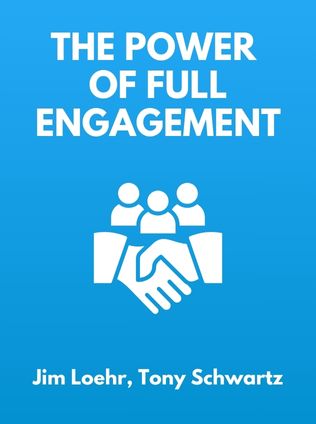
The Power of Full Engagement
Managing Energy, Not Time, Is the Key to High Performance and Personal Renewal
By Jim Loehr, Tony Schwartz
Published 01/2003
About the Author
Jim Loehr and Tony Schwartz bring together a wealth of knowledge and experience in the fields of performance psychology and energy management. Loehr, a seasoned psychologist, is the chairman and CEO of LGE Performance Systems, an organization dedicated to helping individuals and organizations achieve peak performance. He has authored numerous books, including the well-known "Stress for Success," and has worked with elite athletes, law enforcement officials, and corporate executives. His expertise lies in understanding the psychological underpinnings of high performance, resilience, and stress management.
Tony Schwartz, on the other hand, is a leading expert in the area of energy and productivity. As the founder and president of The Energy Project, he has helped numerous organizations, including Fortune 500 companies, optimize their energy and performance. Schwartz's work focuses on the science of energy management, exploring how individuals can harness their physical, emotional, mental, and spiritual energies to achieve their best selves. His previous works, such as "The Art of the Deal" and "What Really Matters: Searching for Wisdom in America," delve into the intersections of business, psychology, and personal development.
Main Idea
The central theme of "The Power of Full Engagement" is the revolutionary idea that managing energy, rather than time, is the key to achieving high performance and overall well-being. Loehr and Schwartz propose that individuals have four primary types of energy—physical, emotional, mental, and spiritual—that must be nurtured and balanced to achieve sustainable peak performance. They argue that traditional time management techniques often overlook the importance of energy levels, leading to burnout and decreased productivity. By focusing on energy management, individuals can not only enhance their productivity but also experience greater fulfillment and balance in their lives.
This holistic approach emphasizes the need for regular cycles of energy expenditure and renewal. The authors liken this to the natural rhythms found in nature, such as the seasons or the sleep-wake cycle, suggesting that humans too function best when they honor these natural rhythms. By understanding and optimizing these energy cycles, individuals can achieve what the authors call "full engagement," a state where one is fully present and energized, capable of performing at their highest level.
Table of Contents
- Introduction
- The Four Forms of Energy
- The Importance of Balance
- Developing Positive Habits and Rituals
- Conclusion
The Four Forms of Energy
In "The Power of Full Engagement," Loehr and Schwartz identify four critical types of energy that are essential for achieving peak performance: physical, emotional, mental, and spiritual. Each type of energy plays a unique role in our overall functioning and must be managed effectively to maintain balance and high performance.
Sign up for FREE and get access to 1,400+ books summaries.
You May Also Like
The Subtle Art of Not Giving a F*ck
A Counterintuitive Approach to Living a Good Life
By Mark MansonRich Dad Poor Dad
What the Rich Teach Their Kids About Money - That the Poor and Middle Class Do Not!
By Robert T. KiyosakiHow To Win Friends and Influence People
The All-Time Classic Manual Of People Skills
By Dale CarnegieFreakonomics
A Rogue Economist Explores the Hidden Side of Everything
By Steven D. Levitt and Stephen J. Dubner



















